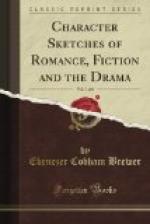Edith, daughter of Baldwin, the tutor of Rollo and Otto, dukes of Normandy.—Beaumont and Fletcher, The Bloody Brother (1639).
Edith, the “maid of Lorn” (Argyllshire), was on the point of being married to Lord Ronald, when Robert, Edward, and Isabel Bruce sought shelter at the castle. Edith’s brother recognized Robert Bruce, and being in the English interest a quarrel ensued. The abbot refused to marry the bridal pair amidst such discord. Edith fled and in the character of a page had many adventures, but at the restoration of peace, after the battle of Bannockburn, was duly married to Lord Ronald.—Sir W. Scott, Lord of the Isles (1815).
Edith (the lady), mother of Athelstane “the Unready” (thane of Conningsburgh).—Sir W. Scott, Ivanhoe (time, Richard I.).
Edith [GRANGER], daughter of the Hon. Mrs. Skewton, married at the age of 18 to Colonel Granger of “Ours,” who died within two years, when Edith and her mother lived as adventuresses. Edith became Mr. Dombey’s second wife, but the marriage was altogether an unhappy one, and she eloped with Mr. Carker to Dijon, where she left him, having taken this foolish step merely to annoy her husband for the slights to which he had subjected her. On leaving Carker she went to live with her cousin Feenix, in the south of England.—C. Dickens, Dombey and Son (1846).
EDITH PLANTAGENET (The lady), called “The Fair Maid of Anjou,” a kinswoman of Richard I., and attendant of Queen Berenga’ria. She married David, earl of Huntingdon (prince royal of Scotland), and is introduced by Sir W. Scott in The Talisman (1825).
EDMUND, natural son of the earl of Gloucester. Both Goneril and Regan (daughters of King Lear) were in love with him. Regan, on the death of her husband, designed to marry Edmund, but Goneril, out of jealousy, poisoned her sister Regan.—Shakespeare, King Lear (1605).
Edmund Andros. In a letter to English friends (1698) Nathaniel Byfield writes particulars of the revolt in the New England Colonies against the royal governor, Sir Edmund Andros.
“We have, also, advice that on Friday last Sir Edmund Andros did attempt to make an escape in woman’s apparel, and passed two guards and was stopped at the third, being discovered by his shoes, not having changed them.” Nathaniel Byfield.—An Account of the Late Revolution in New England (1689).
Edmund Dante (See MONTE CRISTO).
EDO’NIAN BANE (The), priestesses and other ministers of Bacchus, so called from Edo’nus, a mountain of Thrace, where the rites of the wine-god were celebrated.
Accept the rites your bounty well may
claim,
Nor heed the scoffing of th’ Edonian
band.
Akinside, Hymn to the Naiads (1767).
EDRIC, a domestic at Hereward’s barracks.—Sir W. Scott, Count Robert of Paris (time, Rufus).




